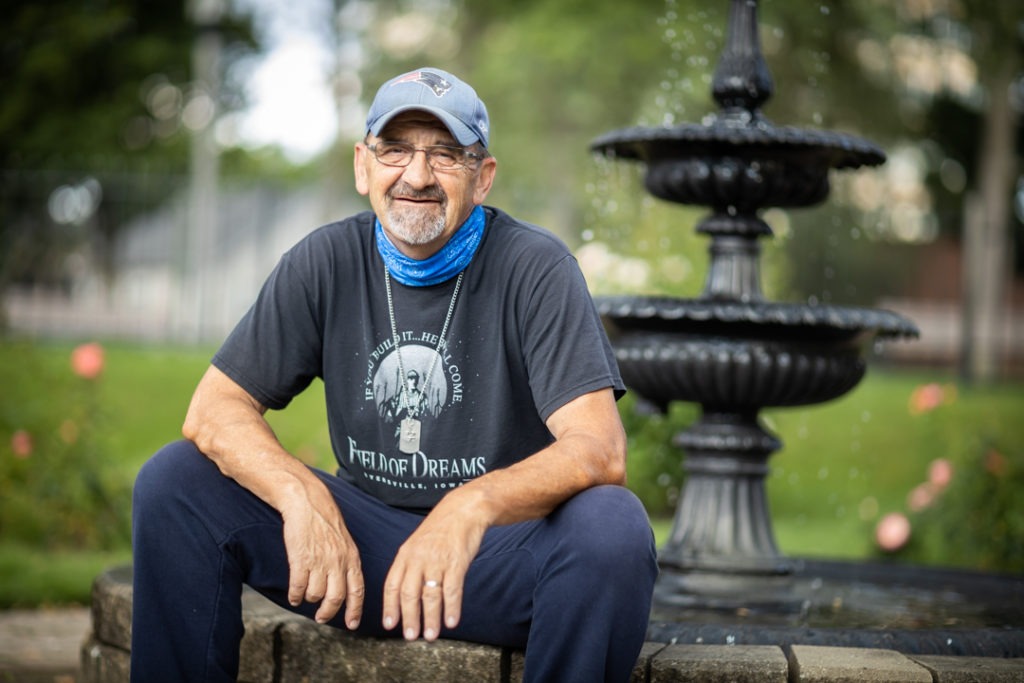
Virtual care program helps patient avoid trip to hospital emergency department
It was 10:30 at night when Ernst Seeger realized he needed immediate medical attention. The Niagara Falls man was at home recovering from bladder cancer surgery and started experiencing intense, escalating abdominal pain.
But instead of going to the hospital emergency department, Seeger, 64, reached out to his virtual healthcare team at Hamilton Health Sciences (HHS) using a tablet computer provided by the hospital as part of a study on virtual care for patients recovering at home after surgery.
“I’m glad you called. That’s what we’re here for.”
“I apologized for contacting them so late but the nurse I spoke to said, `I’m glad you called. That’s what we’re here for.’”
Technology transforming health care
While at the HHS Juravinski Hospital and Cancer Centre having surgery for bladder cancer in May, Seeger was invited to take part in the study to test virtual care and remote monitoring technology once he was discharged. Investing in research and technology is part of HHS’ vision to transform the way health care is provided, in order to deliver a more patient-centred and seamless healthcare system. This includes opportunities for patients to recover at home with virtual care and remote monitoring technology.
The study – called post-discharge after surgery using virtual care with remote automated monitoring (PVC-RAM) – was launched in response to challenges that hospitals were facing due to COVID-19. When restrictions came into place in early March due to the pandemic, hospitals looked for ways to drastically reduce non-emergency care. Patients were sent home earlier after surgery where possible, and many in-hospital appointments were replaced with virtual visits. These virtual care visits help address serious complications that might otherwise lead to emergency department visits or readmissions.
A team of researchers and health care providers at HHS and McMaster University launched the study through their joint research centre, the Population Health Research Institute (PHRI). The study is led by Drs. PJ Devereaux and Michael McGillion. Devereaux is an HHS cardiologist, McMaster professor and senior scientist at PHRI. McGillion is the assistant dean of research at McMaster’s School of Nursing and a PHRI scientist.
Infection detected
Nurses run the central command centre collaboratively with perioperative physicians and use a tablet computer to interact with patients. They can also connect patients to physicians using this technology.
Patients receive technology called Connected Health by Cloud DX, which includes a tablet and remote monitoring equipment to assess blood pressure, heart rate, respiratory rate, oxygen saturation, temperature and weight. Patients record their vital signs at home, which are sent instantly to the nurse. These nurses assess the patients and escalate care to physicians when immediate medical assessment and intervention are required.
“It gave me a lot of confidence to know that the virtual team was there 24/7.”
During his episode, Seeger spoke with a virtual-care nurse through video conferencing and used a tablet to send a photo of his surgical scar which appeared inflamed. The nurse consulted with a physician and Seeger was diagnosed with having an infection and prescribed medication.
“I picked up my medication the next morning at my pharmacy which is about 150 feet from my apartment,” said Seeger, who was thrilled to receive timely medical care from the comfort of his own home.
“It gave me a lot of confidence to know that the virtual team was there 24/7 in case I needed help. Everyone I spoke to through the program was very professional, helpful and on their game. They were always there for me.”
Virtual intervention
“Ernst’s experience is a great example of how our virtual care teams can quickly intervene to help patients, saving them a trip to the emergency department or readmission to hospital,” said Dr. Ted Scott, Vice President of Research and Chief Innovation Officer for HHS. “Our staff involved in this study have seen many examples where virtual care has helped address complications that would otherwise have meant a trip to the hospital. We are tracking these instances as part of the study.”
Seeger doesn’t consider himself to be tech savvy. His wife was more comfortable with the home monitoring technology and helped him learn the system. “The technology was pretty amazing,” said Seeger, who learned it fairly quickly. He has since finished the study, is on the road to recovery and back to work as a truck driver.
“It feels great to be back at work again and have life start returning to normal.”
Related:
Virtual care allows patient to recover at home after heart surgery
Introducing a Registered Nurse specializing in digital health care
HHS, McMaster University and PHRI launch a national, post-operative virtual care study
